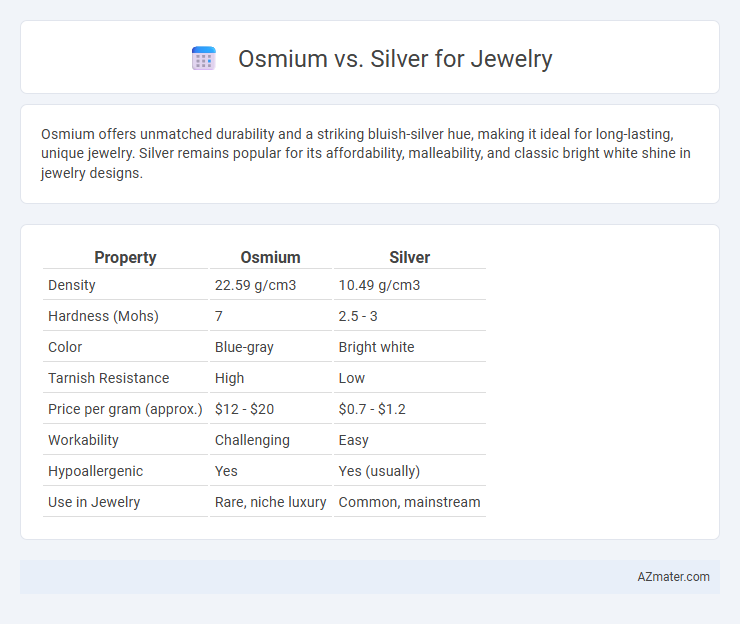Osmium offers unmatched durability and a striking bluish-silver hue, making it ideal for long-lasting, unique jewelry. Silver remains popular for its affordability, malleability, and classic bright white shine in jewelry designs.
Table of Comparison
| Property | Osmium | Silver |
|---|---|---|
| Density | 22.59 g/cm3 | 10.49 g/cm3 |
| Hardness (Mohs) | 7 | 2.5 - 3 |
| Color | Blue-gray | Bright white |
| Tarnish Resistance | High | Low |
| Price per gram (approx.) | $12 - $20 | $0.7 - $1.2 |
| Workability | Challenging | Easy |
| Hypoallergenic | Yes | Yes (usually) |
| Use in Jewelry | Rare, niche luxury | Common, mainstream |
Introduction to Osmium and Silver in Jewelry
Osmium, one of the rarest and densest metals, offers exceptional durability and a unique bluish-silver hue, making it an innovative choice for high-end jewelry. Silver, prized for its bright luster, affordability, and excellent malleability, remains a popular metal in jewelry crafting worldwide. While silver is widely accessible, osmium's rarity and hardness cater to exclusive designs that require lasting resilience and striking appearance.
Unique Physical Properties Compared
Osmium is one of the rarest and densest metals on Earth, boasting remarkable hardness and a distinctive bluish-silver hue, which contrasts with silver's softer, malleable nature and bright white shine. Unlike silver, which tarnishes easily due to oxidation, osmium exhibits exceptional resistance to wear, corrosion, and tarnish, making it highly durable for long-lasting jewelry. The significant difference in density means osmium jewelry feels substantially heavier than silver, adding a unique tactile experience that appeals to luxury and novelty seekers.
Aesthetic Differences: Appearance and Luster
Osmium exhibits a unique bluish-silver hue with a distinct metallic luster that remains highly reflective and resistant to tarnish, providing a modern, industrial aesthetic. Silver features a bright white shine with a warm glow but tends to develop patina and tarnish over time, requiring regular polishing to maintain its luster. The contrast between osmium's dark, steely finish and silver's classic, shiny brilliance offers diverse stylistic options for jewelry design.
Durability and Wear Resistance
Osmium offers exceptional durability and wear resistance due to its hardness and dense atomic structure, making it highly resistant to scratches and corrosion compared to silver. Silver, while popular for its luster and affordability, is relatively soft and prone to tarnishing and scratching over time, necessitating more frequent maintenance. Jewelry crafted from osmium provides a long-lasting, resilient alternative for those seeking durable pieces with minimal wear.
Hypoallergenic Qualities and Skin Safety
Osmium is highly valued for its hypoallergenic properties, making it an excellent choice for jewelry wearers with sensitive skin or metal allergies, as it rarely causes irritation or allergic reactions. Silver, while popular and affordable, often contains nickel or other alloying metals that can trigger allergic responses in some individuals. Choosing osmium jewelry ensures enhanced skin safety and durability, especially for those prone to metal sensitivities.
Rarity and Market Value
Osmium is one of the rarest metals on Earth, significantly rarer than silver, with an annual production of only a few tons compared to silver's thousands of tons. Its scarcity drives an exceptionally high market value, making osmium jewelry more exclusive and expensive than silver pieces. Silver remains more accessible and affordable due to its abundance and widespread use in jewelry, despite its lower intrinsic market value.
Workability and Craftsmanship Challenges
Osmium's extreme hardness and brittleness present significant workability challenges compared to silver's malleable and ductile nature, which allows for easier shaping and intricate detailing in jewelry craftsmanship. Crafting osmium pieces requires specialized equipment and techniques to prevent cracking and ensure precision, whereas silver's softness permits more traditional methods such as soldering and engraving. These factors make silver a preferred choice for jewelers prioritizing flexibility and ease of design refinement.
Maintenance and Tarnish Resistance
Osmium jewelry exhibits exceptional tarnish resistance due to its dense, inert properties, requiring minimal maintenance compared to silver, which is prone to oxidation and tarnishing over time. Silver jewelry demands regular cleaning with special polishing cloths or solutions to maintain its shine, whereas osmium's durability ensures long-lasting luster with occasional light cleaning. Choosing osmium reduces the need for frequent upkeep and preserves a pristine appearance, making it ideal for low-maintenance luxury jewelry.
Popular Uses and Design Trends
Osmium and silver offer distinct advantages in jewelry, with silver favored for its classic appeal and affordability, making it popular in everyday wear and intricate designs. Osmium's rarity and high density contribute to unique, modern pieces that highlight durability and a distinctive bluish-silver luster, appealing to luxury market trends. Recent design trends emphasize osmium's use in minimalist and statement jewelry, while silver remains dominant in vintage-inspired and customizable collections.
Sustainability and Ethical Sourcing
Osmium offers a highly sustainable alternative to silver in jewelry due to its rarity and exceptional durability, which reduces the need for frequent replacements and mining activities. Unlike silver, which often involves environmentally damaging extraction processes and potential exploitation of labor in mining regions, osmium is typically sourced as a byproduct of platinum and nickel refining, minimizing additional environmental impact. Ethical sourcing of osmium is more trackable and controlled, promoting responsible supply chains compared to the widespread challenges faced in the silver industry.

Infographic: Osmium vs Silver for Jewelry
 azmater.com
azmater.com